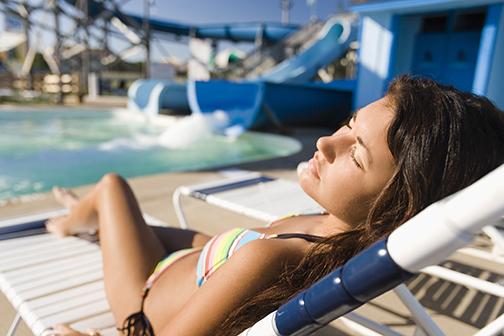Everyone at some point has wanted a “healthy glow,” whether it’s a must-have for summer, or a vacation, the thought of tan skin has crossed the minds of millions. If you are pale, it takes a lot of time and effort to tan. There is a wild excitement after realizing a day in the sun my skin is tan, not burnt. Surely everyone is familiar with the famous conversation upon the realization that you got fried at the beach. Your friends reassure you with “Don’t worry it’ll turn into a tan.” It may all seem like fun and games at the time, put on a little aloe and the color fades, but alarming new research has taken the healthy out of healthy glow.
Some tan-seeking Americans do it the old-fashioned way, grab a towel and headphones and hit the pool or beach. Recently, millions of young girls have been turning to tanning beds instead. Regardless of how the tan is achieved, any change in skin coloring is evidence of skin cell damage. This damage can lead to premature wrinkles, and who wants that? Skin damage can more fatally lead to cancer. According to the Skin Cancer Foundation, melanoma among people aged 18 to 39 has risen dramatically. In the past 40 years melanoma rates have risen nearly 800 percent for young women and 400 percent for men. Generally the risk of melanoma is slightly greater for men than women, but recent findings have discovered and explained this now reversed pattern. More and more young girls are converting to tanning beds. The idea of a quick, effortless and even tan is a huge attraction for girls who believe a tan is what they need. Regardless of what advertisements may have many believing, the concentrated amount of ultraviolet rays emitted by tanning beds can, overtime, increase users chances of getting melanoma by 74 percent. According to the Food and Drug Administration, just one use of a tanning bed can increase one’s chances of getting melanoma by 20 percent. In the United States the number of skin cancer cases due to indoor tanning, is higher than the number of lung cancer cases due to smoking. Whether the tan came from the sun or from a tanning bed, all Americans need to better protect themselves.
While it is true that being outside and active is great for your body and the sun does provide vitamin D, everyone’s health still needs protecting. Bringing the alarming new data to light has inspired many people to get their skin checked by a doctor. This has resulted in many early diagnoses and has decreased the fatality rate of melanoma. The suggestions from the Skin Cancer Foundation include: avoiding indoor tanning, limiting time spent in direct sunlight, between the hours of 10 a.m. and 4 p.m., wearing sunscreen at all times and getting a skin check once a year. Sunscreen has been the popular choice for years, but mastering it can be tricky. The best sunscreens have an SPF above 15. Recently many sunscreens were tested and only two brands, Coppertone and Equate, proved to have products that contain the same amount of SPF as stated on the bottle. Sunscreen also needs to be reapplied after time and activity. A fashionable option is the sun hat; Coolibar provides a variety of options both elegant and fun. Big floppy hats may seem ridiculous at first, but they are actually quite classy accessories. The sad but true fact is that the desire for tan skin still exists in many. My advice is to look into sunless tanners, as Farah K. Ahmed. When it comes to sunless tanners it really is all about personal preference. There is a variety of brands and levels of tanner. From personal experience, Jergens, Clinique, L’Oreal, Equate and St. Tropez, have been great gradual products. The best thing about sunless tanning is the cost. Most bottles run for about $8.00 and in no way endanger the lives of users. As the Skin Cancer Foundation says, “Fake it, don’t bake it.”












